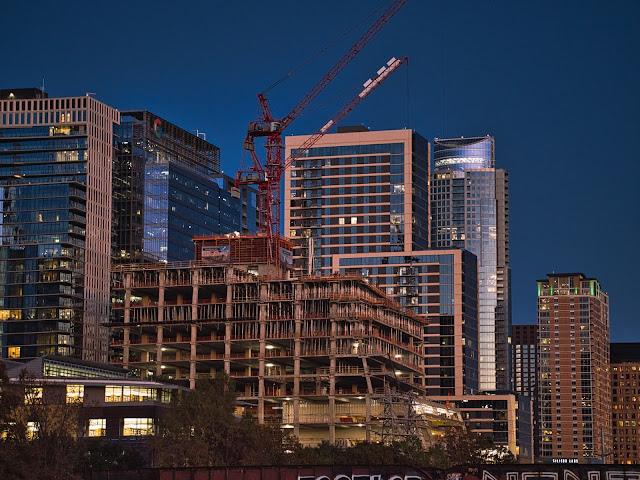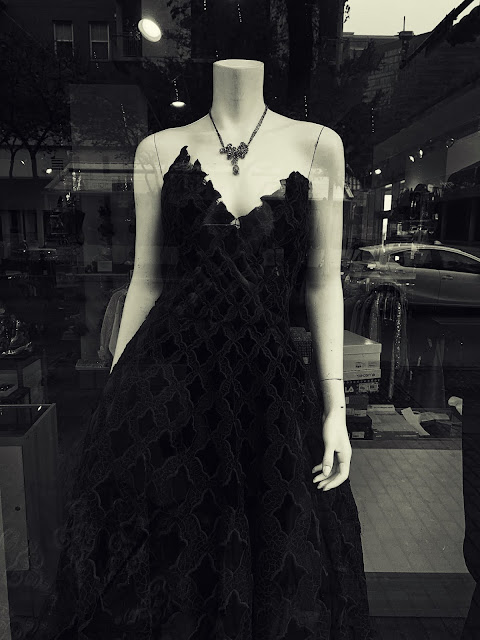It wasn't raining when I went to swim practice today. The temperature hovered around 60° and if there was a breeze I didn't feel it. I swam in a lane with Sheila and Ed and we did our best to socially distance and still keep a uniform pace and workout strategy. I liked two things about today's workout: the ominous skies overhead and the "swim ladder" that we did in the middle of the workout. You basically start with a 200 yard swim, then a 150 then a 100, then a 50 and you work your way back up the "ladder" to the 200. Do the set two or three times in a row and it really helps you with your pacing. You want to get faster on the 50s but you want to keep a pace you can handle on the 200s.
By the time I got home a gentle rain started coming down and the temperature started to nudge down too. The rain has gotten stronger over the course of the day and the temp is slowly heading toward the 40's.
After reading so many blog posts about veganism at my favorite photography blog, and after running in to Austin's most famous vegan-tarian at the pool this morning, I had a strong urge to un-comform and go counter to the cult trends today. To that end I got out a big, heavy cast iron frying pan and set it on the stove top. I foraged in the fridge for that package of hormone free, dry rubbed, thick-sliced bacon I bought this past week at Whole Foods (of course they have bacon --- how else can you cure people of vegetarianism?) and put six big slices into the pan.
I turned them over and over again to get the bacon strips crispy but still chewy. While I was engineering the perfect rasher of bacon I brewed up 16 ounces of Columbian Supremo coffee and stuck some fresh, sourdough bread in the toaster. I splurged with the coffee and tossed in some half-and-half that someone stocked in for the holidays. Then I pulled two brown-shelled eggs out of the fridge and fried them over easy.
I do respect some limits; all six slices of bacon were not for me. I knew Belinda would enjoy one slice before detouring back to healthier fare and I knew Ben would eat two slices, if he decided to wake up.
The eggs wound up on top of the perfectly browned toast and made for a delightful post-swim breakfast.
While this is not a routine breakfast for me it was a nice change from the bowl of fresh berries, mixed with muesli and low fat Greek yogurt. Yesterday I subbed the blackberries and blueberries for cranberries. It was festive. But also not an every day thing. Ben appreciated the rare treat of bacon ready made for him.
Cameras. Can a camera be too eccentric? I guess it depends on how you use cameras and what kinds of options you have in choosing cameras on a day-by-day or job-by-job basis. I will say that if one started photography in the midst of the digital camera age then the Sigma fp might be right out there on the edge of happy usability. On the other hand, if you started your imaging journey learning on 8 x10 inch view cameras that were fitted with 5 x7 inch reducing backs then I'd say a modern camera would have to be pretty far out on the weirdness spectrum to be too eccentric. And I guess that's the relationship I have with the mysterious fp. And part of the affection I had for Pentax's K-01.
I can't quite ever get the fp configured exactly right but I think I'm closing in on it for one variety of my still photography. Video with the camera I've got figured out. It all came together for me in that medium when I paired it with an external monitor. But I'm certainly not entertaining making it a practice of walking around with an external monitor clamped to the top of the camera when taking photographs.
Every once in a while I get frustrated with the little camera. There are times when I feel like I just have to have an eyelevel viewfinder and so I bolt the big loupe to the back. But then the camera becomes so ungainly that it takes all the fun out of walking around with it. At that point I go back to the office and rummage through the Lumix inventory for something more convenient and fun to carry. When the friction of use settles in and aggravates me like a blister on your heel when you are breaking in new hiking boots, I think about selling it to some unsuspecting but well-heeled photographer who might have a masochistic bent.
But then I take an image that is so uniquely fp and so profoundly beautiful (to me) that I fall in love with the small machine all over again. In the first week of this month I was asked to make a few portraits for two friends who own an ad agency. We've know each other for quite a while and they are given to saying things like: "We love the way you shoot. Make the portraits any way you like them. I'm sure we'll love them."
Given full license to play I pulled out the Sigma fp and put the 90mm f2.8 Leica R Elmarit lens on the front. I also changed the aspect ratio to 1:1 and set the file selector to 14 bit DNG+Jpeg. A couple days before the scheduled sessions I put the camera through every color profile set-up available, and tried dozens and dozens of tweaks. But I knew I'd end up using the Jpegs only as guides while leaning on the DNG files and a good dose of Photoshop to get me where I wanted to go.
As a side note, have any of you played with the LUTs that are now available under the "Image > Adjustments > Color Lookup" setting? I presume that these cinema-oriented LUTs are there for those times when foolhardy people try to edit their entire video project in PhotoShop instead of retreating to Final Cut Pro X or Premiere. But the LUTs work just fine as wonderfully weird visual adventure starting points with photographs as well. I've been trying out all of the LUTs and then using the "fade" control under the "edit" menu in PS to change the strengths of their visual effects.
On that particular portrait project I stuck with the Sigma fp all the way through. I think I got images that I might not have been able to get if I had used a different camera. Those recipes for color, contrast, noise and what not are really quite different from camera to camera and from brand to brand.
I love some of the stuff I've been able to get with that little gray brick. And I really enjoy using all the crazy lenses I've bought, and also adapted for use on the L system cameras. But something about the fp is just addictive. I guess it's like all those people who are reviving single speed bicycles. Or shooting film in nasty old hand cranked cameras. Maybe the friction of the camera's operational quirks, and the lack of features some photographers feel like they can't live without, drives those of us using
fp's to work harder at trying to make them work. But the thrill of victory is always sweeter when the pathway to glory is tougher.
The Passion is in the Risk.
Anyway, I recently started musing about using the fp more and more in the manner I used to work with my old, square format film cameras. I never worried about how cumbersome they were to drag around and I never hesitated to screw them onto tripods, and take my time making portraits with them. Today I spent time putting together the fp for its debut as a mini-Hasselblad. The taking lens for my latest foray is something like the 110 f2.0 Planar lens I had for the 205TCC version of the camera. I originally got that lens in a deal with a 2003f camera. It was a charming, fast "long normal" focal length for the two and a quarter format. The 50mm f1.4 S-Pro lens from Panasonic for the L system is much like that old Planar when it comes to analogous focal length and aperture, and I like manually focusing it (although it's more fun to focus when it's on the S1R with the lens menu set to provide a long, long manual focus throw).
After I got the camera set up and dialed in for studio work I cajoled my captive housemates to take turns sitting for a bare minimum amount of time so I could see how the whole melange works. It works well. Very well. I guess I'm stumbling down a new/retro pathway back to how I shot with some film cameras. But we'll see.
Like any craftsperson with an outsized appreciation for his tools I felt compelled to photograph the bizarre combination of camera and lens. And I swear the lens weighs three times what the body does.
I have been playing with a new app on my iPhone XR called FirstLight and I wanted to see just what I could do with that. See if I could coax something sparkly out of the fp+S-Pro combo. I set the phone app to shoot in Tiff format. I could have used .DNG but you don't get access to the "look" filters if you do that. I shot images of the beautiful couple and I present them here. I am amazed at the amount of detail and the wonderful tonal gradation the phone is capable of when its native camera app is overridden by a dedicated, full control app. Anyway, pix below. Sit in front of your 27 inch, 5K Retina monitor and click on them. The pix get big. See if you get what I mean.
SOOC
PS LUT applied.
SAME.




































